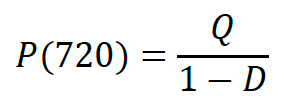Offshore wind developments assessment - seabird collision risk, displacement and barrier effects: study
This project developed a new framework to enable the assessment of collision, displacement and barrier effects on seabirds from offshore renewable developments to be integrated into a single overall assessment of combined impacts.
This document is part of a collection
Appendix B
9.2 Derivation of p(T)
Formula
SeabORD calculates the probability of collision-related mortality for any particular bird on any particular day to be:

where T denotes the amount of time (in hours) that SeabORD simulates this bird to spend in displacement-susceptible behaviours on this day (this will be zero for birds that are displacement-susceptible), D represents the proportion of displacement-susceptible birds in the population, and Q represents the collision mortality rate per bird-month. Q is the average, across months within the chick-rearing period, of (predicted number of collisions from sCRM / (density of birds in footprint * footprint area)) – i.e. the probability of collision mortality per month spent in the footprint.
Derivation
Step 1. The value of Q relates to the entire population of birds that use the OWF footprint within the baseline period – i.e. in the absence of an OWF. This will include birds that are displaced by the OWF, and so are never actually susceptible to collision risk. We need to translate this into the collision risk associated with birds actually spending a month within the OWF – i.e. which are not displacement-susceptible, and so are actually susceptible to collision. This rescaling gives us the collision risk associated with a bird spending an entire month [720 hours] in the footprint once the OWF is there:

Step 2. Our model assumes that the mortality rate per unit time is unrelated to the length of the period of time, which implies that the time to mortality follows an exponential distribution. Let S(t) = 1 - P(t) denote the probability of not dying due to collision during a period of length ; it follows immediately from the properties of the exponential distribution that S(t) = S(1) t.
Step 3. From Steps 1 and 2 it follows that:

Contact
Email: ScotMER@gov.scot
There is a problem
Thanks for your feedback